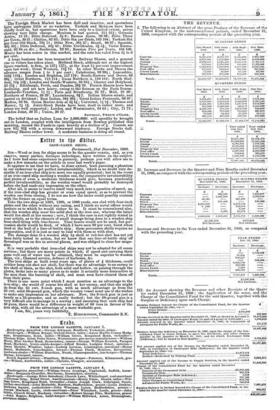Itttn to tbr Eititur.
IRON-CABED SHIPS.
Portsmouth, 31st December, 1860. SIR-Wood or iron for ships seems to be the questio vexata, and, as you observe, many parties, doctique indoetique, have written on the subject. As I have had some experience in gunnery., perhaps you will allow me to make a few remarks on the article in your last week's paper. -It appears to me that we have, to Some extent, been pursuing a phantom in our endeavour to get perfect invulnerability, which is no doubt very de- sirable if an ion-clad ship is to meet one equally protected ; but in the event of an iron-cased ship meeting a wooden one, the comparative invulnerability that plates of even a moderate thickness would give, becomes practically perfect invulnerability, as the wooden vessel would probably be destroyed before she had made any impression on the other.
After sll, it seems to resolve itself very much into a question of speed, as, if the iron-clad ship has greater or even equal speed, so as to prevent the wooden one from closing, I do not see how the latter could possibly contend with the former on equal terms.
Take the two ships at 1500, 1200, or 1000 yards, one clad with four-inch plates and the other without any casing, and I think no naval officer would hesitate as to which he would rather be in. It must be remembered also, that the wooden ship must fire solid shot at the iron one, whereas the latter would fire shell at her enemy ; now, I think the case is not rightly stated in your article, as to the chances of small damage being done to a wooden ship from shell firing with time fuzees. Time fuzees would not be used, but per- cussion shells would be fired, of which I have seen 90 per cent, burst when fired at the hull of a line-of-battle ship : these percussion shells require no preparation, and it is just as easy to load with them as with shot.
_ The damage done to a wooden ship by shell or red-hot shot has not yet been fairly tested in action, but we know that one line-of-battle ship off Sevastopol was on fire in several places, and was obliged to close her maga- zine.
1- It is very probable that iron-clad ships may not be adapted for all ocean services ; but there are many points in which, if speed and carrying their ens well out of water can be obtained, they must be superior to wooden viz., Channel service, defence of harbours, &c. T iron ron ships as built some years ago, of plates of 4 thickness, could neither keep out shot nor shell, but there was no advantage to an enemy to fire shell at them, as the shot, both solid and hollow, on passing through the plates, broke into so many pieces as to make it actually more destructive to the men than the bursting of shell, and must soon have cleared them off from their guns. _ There is one more point which I must mention as an advantage to the iron ship ; she would of course fire shell at her enemy, and that she might do from the 65 cwt. 8-inch gun, with 418 much advantage as from the 95 cwt. solid 68-pound gun, which the wooden vessel must use if she wishes to make any impression on her adversary. Now, the 8-inch gun is just as 4:andy as a 32-pounder, and as easily worked ; but the 68-pound gun is a very difficult one to manage in a seaway ; and assuming that each ship had 40 guns, there would be a difference in weight of 6Q tons in favour of the ii-on ship, with all the advantage of a more workable gun.
I am, Sir, yours very faithfully,
T. HODGEINBON, Commander R.N.






























 Previous page
Previous page